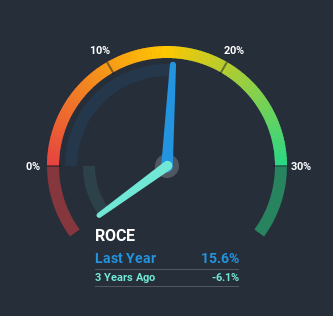Here's What To Make Of Camlin Fine Sciences' (NSE:CAMLINFINE) Returns On Capital

If we want to find a stock that could multiply over the long term, what are the underlying trends we should look for? Ideally, a business will show two trends; firstly a growing return on capital employed (ROCE) and secondly, an increasing amount of capital employed. Ultimately, this demonstrates that it's a business that is reinvesting profits at increasing rates of return. However, after briefly looking over the numbers, we don't think Camlin Fine Sciences (NSE:CAMLINFINE) has the makings of a multi-bagger going forward, but let's have a look at why that may be.
What is Return On Capital Employed (ROCE)?
For those who don't know, ROCE is a measure of a company's yearly pre-tax profit (its return), relative to the capital employed in the business. To calculate this metric for Camlin Fine Sciences, this is the formula:
Return on Capital Employed = Earnings Before Interest and Tax (EBIT) ÷ (Total Assets - Current Liabilities)
0.16 = ₹1.2b ÷ (₹13b - ₹5.1b) (Based on the trailing twelve months to September 2020).
So, Camlin Fine Sciences has an ROCE of 16%. That's a relatively normal return on capital, and it's around the 14% generated by the Chemicals industry.
View our latest analysis for Camlin Fine Sciences

Above you can see how the current ROCE for Camlin Fine Sciences compares to its prior returns on capital, but there's only so much you can tell from the past. If you'd like, you can check out the forecasts from the analysts covering Camlin Fine Sciences here for free.
How Are Returns Trending?
In terms of Camlin Fine Sciences' historical ROCE movements, the trend isn't fantastic. Around five years ago the returns on capital were 43%, but since then they've fallen to 16%. However, given capital employed and revenue have both increased it appears that the business is currently pursuing growth, at the consequence of short term returns. And if the increased capital generates additional returns, the business, and thus shareholders, will benefit in the long run.
On a side note, Camlin Fine Sciences has done well to pay down its current liabilities to 39% of total assets. That could partly explain why the ROCE has dropped. Effectively this means their suppliers or short-term creditors are funding less of the business, which reduces some elements of risk. Some would claim this reduces the business' efficiency at generating ROCE since it is now funding more of the operations with its own money.In Conclusion...
In summary, despite lower returns in the short term, we're encouraged to see that Camlin Fine Sciences is reinvesting for growth and has higher sales as a result. In light of this, the stock has only gained 26% over the last five years. Therefore we'd recommend looking further into this stock to confirm if it has the makings of a good investment.
If you want to know some of the risks facing Camlin Fine Sciences we've found 4 warning signs (1 is a bit unpleasant!) that you should be aware of before investing here.
While Camlin Fine Sciences may not currently earn the highest returns, we've compiled a list of companies that currently earn more than 25% return on equity. Check out this free list here.
If you decide to trade Camlin Fine Sciences, use the lowest-cost* platform that is rated #1 Overall by Barron’s, Interactive Brokers. Trade stocks, options, futures, forex, bonds and funds on 135 markets, all from a single integrated account. Promoted
New: AI Stock Screener & Alerts
Our new AI Stock Screener scans the market every day to uncover opportunities.
• Dividend Powerhouses (3%+ Yield)
• Undervalued Small Caps with Insider Buying
• High growth Tech and AI Companies
Or build your own from over 50 metrics.
This article by Simply Wall St is general in nature. It does not constitute a recommendation to buy or sell any stock, and does not take account of your objectives, or your financial situation. We aim to bring you long-term focused analysis driven by fundamental data. Note that our analysis may not factor in the latest price-sensitive company announcements or qualitative material. Simply Wall St has no position in any stocks mentioned.
*Interactive Brokers Rated Lowest Cost Broker by StockBrokers.com Annual Online Review 2020
Have feedback on this article? Concerned about the content? Get in touch with us directly. Alternatively, email editorial-team (at) simplywallst.com.
About NSEI:CAMLINFINE
Camlin Fine Sciences
Engages in the research, development, manufacture, and marketing of specialty chemicals, ingredients, and additive blend products in India and internationally.
Mediocre balance sheet low.
Similar Companies
Market Insights
Community Narratives



